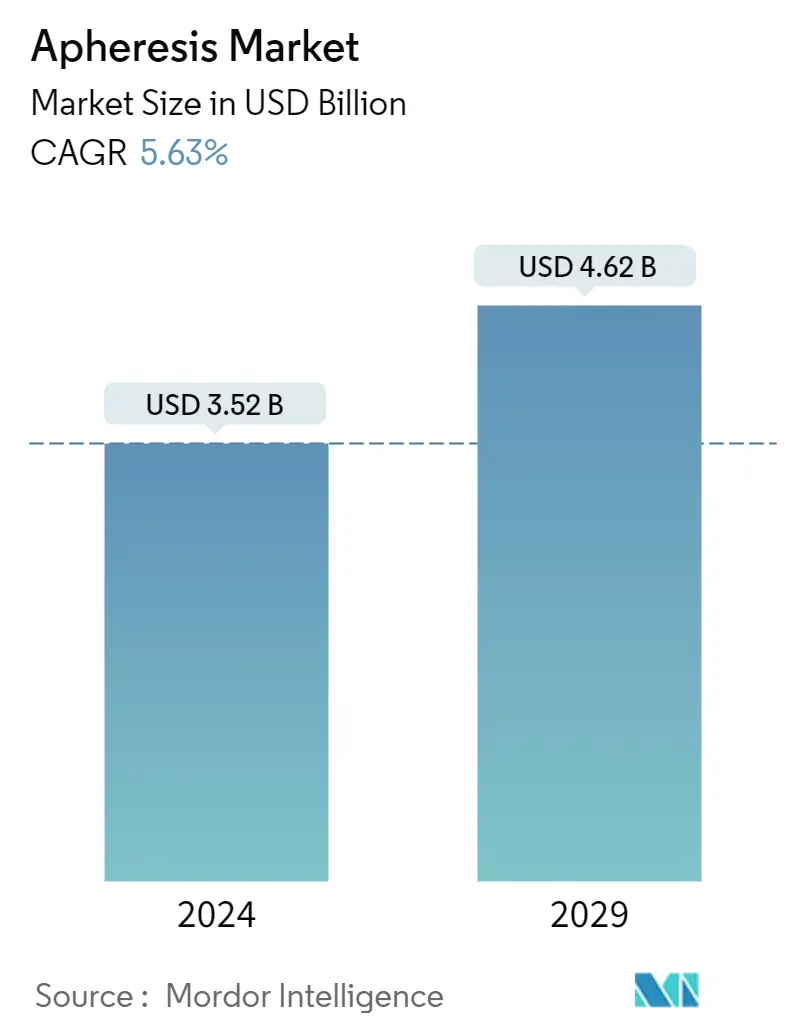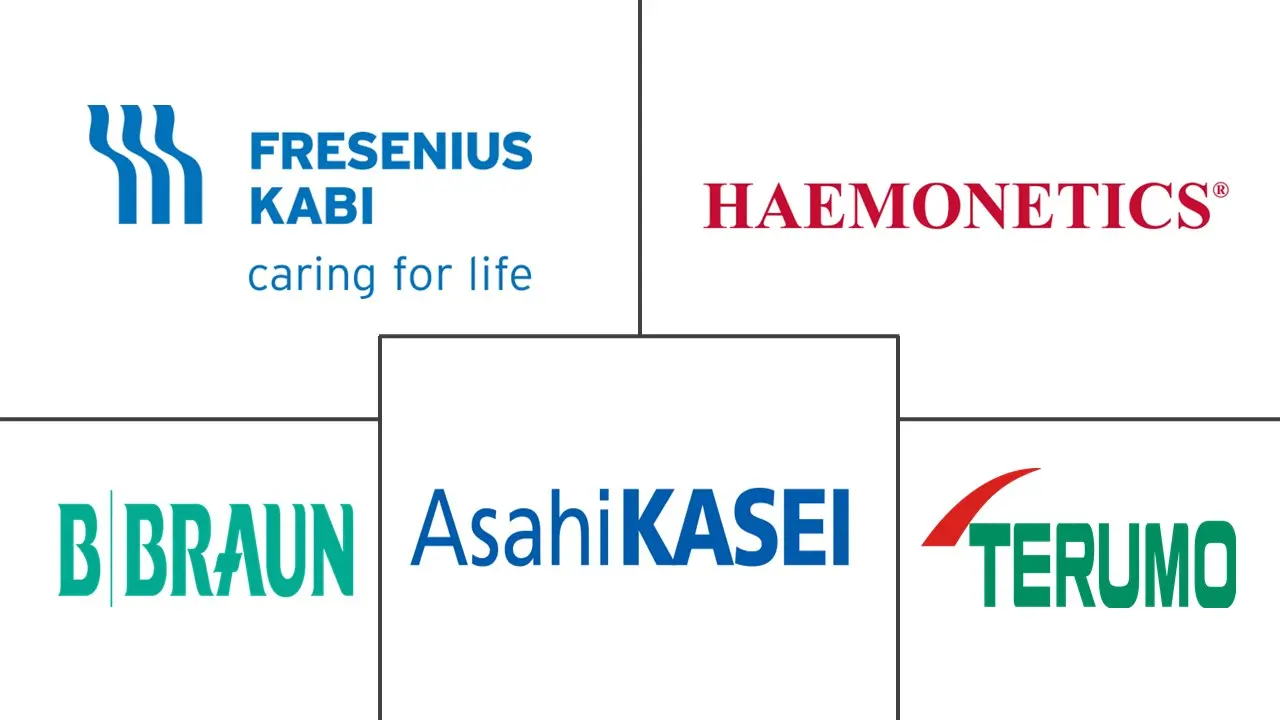Market Size of Apheresis Industry

| Study Period | 2019 - 2029 |
| Market Size (2024) | USD 3.52 Billion |
| Market Size (2029) | USD 4.62 Billion |
| CAGR (2024 - 2029) | 5.63 % |
| Fastest Growing Market | Asia-Pacific |
| Largest Market | North America |
Major Players
*Disclaimer: Major Players sorted in no particular order |
Apheresis Market Analysis
The Apheresis Market size is estimated at USD 3.52 billion in 2024, and is expected to reach USD 4.62 billion by 2029, growing at a CAGR of 5.63% during the forecast period (2024-2029).
The COVID-19 pandemic had a profound impact on the growth of the Apheresis market, due to the extensive application of plasma therapy to treat patients infected with COVID-19. According to the study published in the Journal of Clinical Apheresis in December 2021, the Lack of supplies, notably RBC units and apheresis kits, was one of the main problems with patient treatment in the apheresis facility during the COVID-19 pandemic. Due to "stay home" instructions and concern about SARS CoV2 infection, the number of blood donors drastically reduced. Thus the studied market was initially impacted by the pandemic. Moreover, there were no vaccines or drugs to treat COVID-19, and most doctors opted for convalescent plasma therapy in patients who were severely affected by COVID-19. In this treatment, the plasma extracted from the blood of cured patients by the plasmapheresis technique was transfused into the patient who underwent treatment. Thus, given the wide usage of apheresis units in treating COVID-19 patients and increasing product approvals by the United States Food and Drug Administration (FDA), the apheresis market marked a positive growth during the pandemic, however currently as the pandemic subsided, the market lost some traction, however it is expected to have a stable growth during the forecast period of the study.
The propelling factors for the growth of the apheresis market include the increasing burden of diseases, a rise in the demand for blood components and their associated safety, technological advancements in the development of new apheresis techniques, and an increase in the reimbursement policies and funding for apheresis procedures. For instance, in June 2022, through the NHS MedTech Funding Mandate (MTFM), NHS England in the United Kingdom has chosen the automated red blood cell exchange (RBCX) treatment carried out on the business's Spectra Optia Apheresis System to treat sickle cell disease. Due to this choice, Spectra Optia will be used more frequently in hospitals all around England. Patients with sickle cell illness will now have better access to this therapy. Thus, the increasing funding initiatives related to apheresis are propelling the market growth.
The use of apheresis in clinically ill patients is increasing day by day, and it has been widely used as the primary therapy or as an adjunct to other treatments for various diseases, such as thrombotic thrombocytopenic purpura, hemolytic uremic syndrome, drug toxicities, autoimmune disease, sepsis, and fulminant hepatic failure.
Along with these factors, the increasing product innovations and approvals have been driving the market growth. For instance, in July 2021, Terumo Blood and Cell Technologies announced a direct offering for physicians to perform extracorporeal photopheresis immunotherapy (ECP) procedures at the patient's bedside. The company has expanded the functionality of Spectra Optia. The UVA PIT System ECP can now be performed using these devices as a functionally closed, online, multistep system with mononuclear cell collection (MNC) and continuous mononuclear cell collection (CMNC) protocols.Thus, owing to the aforementioned factors, the apheresis market is expected to witness healthy growth over the forecast period. However, lack of skilled professionals, blood contamination and cost associated with apheresis procedures restrain the market growth.
Apheresis Industry Segmentation
As per the scope of the report, apheresis is a medical technique where the blood of an individual, either a donor or a patient, is passed through an apparatus that segregates out a particular constituent and returns the rest to the blood circulation. It involves blood purification and blood component separation using centrifugation or membrane filtration technology. This procedure is performed for the blood donation component or the treatment of disease. The apheresis market is segmented by product (devices and disposables), apheresis procedure (leukapheresis, plasmapheresis, plateletpheresis, erythrocytapheresis, and other apheresis procedures), technology (centrifugation and membrane separation), application (renal disorders, hematological disorders, neurological disorders, autoimmune disorders, and other applications), and geography (North America, Europe, Asia-Pacific, Middle East and Africa, and South America). The report also covers the estimated market sizes and trends for 17 countries across major regions globally. The report offers the value (in USD million) for the above segments.
| By Product | |
| Devices | |
| Disposables |
| By Apheresis Procedure | |
| Leukapheresis | |
| Plasmapheresis | |
| Plateletpheresis | |
| Erythrocytapheresis | |
| Other Apheresis Procedures |
| By Technology | |
| Centrifugation | |
| Membrane Separation |
| By Application | |
| Renal Disorders | |
| Hematological Disorders | |
| Neurological Disorders | |
| Autoimmune Disorders | |
| Other Applications |
| Geography | ||||||||
| ||||||||
| ||||||||
| ||||||||
| ||||||||
|
Apheresis Market Size Summary
The apheresis market is poised for steady growth over the forecast period, driven by several key factors. The market experienced initial challenges due to the COVID-19 pandemic, which highlighted the critical role of plasma therapy and apheresis units in treating infected patients. Despite these challenges, the market saw positive growth due to increased product approvals and the application of apheresis in COVID-19 treatments. As the pandemic subsided, the market regained stability, supported by the rising burden of diseases, technological advancements, and enhanced reimbursement policies. The growing use of apheresis in treating various conditions, such as autoimmune diseases and hematological disorders, further propels market expansion. Innovations and approvals, like those from Terumo Blood and Cell Technologies, continue to drive the market forward, despite challenges like the shortage of skilled professionals and the costs associated with procedures.
North America is expected to witness significant growth in the apheresis market, fueled by a high incidence of blood-related ailments and a robust healthcare infrastructure. The region benefits from increased awareness and favorable reimbursement policies, which boost the demand for apheresis procedures. Initiatives like Apheresis Awareness Day and strategic collaborations among major players, such as Terumo Corporation and Fresenius SE & Co. KGaA, are expected to further enhance market growth. The market remains moderately competitive, with a few key players dominating, yet it holds potential for expansion in developing regions. Overall, the apheresis market is set to experience healthy growth, driven by technological advancements, increased funding, and the expanding application of apheresis in medical treatments.
Apheresis Market Size - Table of Contents
-
1. MARKET DYNAMICS
-
1.1 Market Overview
-
1.2 Market Drivers
-
1.2.1 Increasing Disease Burden Resulting in Rise in Demand for Blood Components and Associated Safety
-
1.2.2 Technological Advancements in Development of New Apheresis Techniques
-
1.2.3 Rise in Reimbursement Policies and Funding for Apheresis Procedures
-
-
1.3 Market Restraints
-
1.3.1 High Capital Investment and Costs Associated with Apheresis Procedures
-
1.3.2 Shortage of Skilled Professionals
-
1.3.3 Risk of Blood Contamination
-
-
1.4 Porter's Five Forces Analysis
-
1.4.1 Threat of New Entrants
-
1.4.2 Bargaining Power of Buyers/Consumers
-
1.4.3 Bargaining Power of Suppliers
-
1.4.4 Threat of Substitute Products
-
1.4.5 Intensity of Competitive Rivalry
-
-
-
2. MARKET SEGMENTATION (Market Size by Value - USD Million)
-
2.1 By Product
-
2.1.1 Devices
-
2.1.2 Disposables
-
-
2.2 By Apheresis Procedure
-
2.2.1 Leukapheresis
-
2.2.2 Plasmapheresis
-
2.2.3 Plateletpheresis
-
2.2.4 Erythrocytapheresis
-
2.2.5 Other Apheresis Procedures
-
-
2.3 By Technology
-
2.3.1 Centrifugation
-
2.3.2 Membrane Separation
-
-
2.4 By Application
-
2.4.1 Renal Disorders
-
2.4.2 Hematological Disorders
-
2.4.3 Neurological Disorders
-
2.4.4 Autoimmune Disorders
-
2.4.5 Other Applications
-
-
2.5 Geography
-
2.5.1 North America
-
2.5.1.1 United States
-
2.5.1.2 Canada
-
2.5.1.3 Mexico
-
-
2.5.2 Europe
-
2.5.2.1 Germany
-
2.5.2.2 United Kingdom
-
2.5.2.3 France
-
2.5.2.4 Italy
-
2.5.2.5 Spain
-
2.5.2.6 Rest of Europe
-
-
2.5.3 Asia-Pacific
-
2.5.3.1 China
-
2.5.3.2 Japan
-
2.5.3.3 India
-
2.5.3.4 Australia
-
2.5.3.5 South Korea
-
2.5.3.6 Rest of Asia-Pacific
-
-
2.5.4 Middle East and Africa
-
2.5.4.1 GCC
-
2.5.4.2 South Africa
-
2.5.4.3 Rest of Middle East and Africa
-
-
2.5.5 South America
-
2.5.5.1 Brazil
-
2.5.5.2 Argentina
-
2.5.5.3 Rest of South America
-
-
-
Apheresis Market Size FAQs
How big is the Apheresis Market?
The Apheresis Market size is expected to reach USD 3.52 billion in 2024 and grow at a CAGR of 5.63% to reach USD 4.62 billion by 2029.
What is the current Apheresis Market size?
In 2024, the Apheresis Market size is expected to reach USD 3.52 billion.

